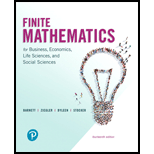
In Problems 41-56, construct a mathematical model in the form of a linear programming problem. (The answer in the back of the book for these application problems include the model.) Then solve the problem using the simplex method. Include an interpretation of any nonzero slack variables in the optimal solution.
Animal nutrition. Repeat Problem 53 if the scientist wants to maximize the daily calcium intake while not allowing the intake of iron or protein to exceed the average daily intake.
Want to see the full answer?
Check out a sample textbook solution
Chapter 6 Solutions
Pearson eText for Finite Mathematics for Business, Economics, Life Sciences, and Social Sciences -- Instant Access (Pearson+)
Additional Math Textbook Solutions
College Algebra (7th Edition)
Introductory Statistics
Calculus: Early Transcendentals (2nd Edition)
University Calculus: Early Transcendentals (4th Edition)
A First Course in Probability (10th Edition)
- 9 (Portfolio allocation) Suppose R₁ and R2 are returns of 2 assets and with expected return and variance respectively r₁ and 72 and variance-covariance σ2, 0%½ and σ12. Find −∞ ≤ w ≤ ∞ such that the portfolio wR₁ + (1 - w) R₂ has the smallest risk.arrow_forward7 (Multivariate random variable) Suppose X, €1, €2, €3 are IID N(0, 1) and Y2 Y₁ = 0.2 0.8X + €1, Y₂ = 0.3 +0.7X+ €2, Y3 = 0.2 + 0.9X + €3. = (In models like this, X is called the common factors of Y₁, Y₂, Y3.) Y = (Y1, Y2, Y3). (a) Find E(Y) and cov(Y). (b) What can you observe from cov(Y). Writearrow_forward1 (VaR and ES) Suppose X ~ f(x) with 1+x, if 0> x > −1 f(x) = 1−x if 1 x > 0 Find VaRo.05 (X) and ES0.05 (X).arrow_forward
- (^) k Recall that for numbers 0 ≤ k ≤ n the binomial coefficient (^) is defined as n! k! (n−k)! Question 1. (1) Prove the following identity: (22) + (1121) = (n+1). (2) Use the identity above to prove the binomial theorem by induction. That is, prove that for any a, b = R, n (a + b)" = Σ (^) an- n-kyk. k=0 n Recall that Σ0 x is short hand notation for the expression x0+x1+ +xn- (3) Fix x = R, x > 0. Prove Bernoulli's inequality: (1+x)" ≥1+nx, by using the binomial theorem. - Question 2. Prove that ||x| - |y|| ≤ |x − y| for any real numbers x, y. Question 3. Assume (In) nEN is a sequence which is unbounded above. That is, the set {xn|nЄN} is unbounded above. Prove that there are natural numbers N] k for all k Є N. be natural numbers (nk Є N). Prove thatarrow_forwardQuestion content area top Part 1 Find the measure of ABC for the congruent triangles ABC and Upper A prime Upper B prime Upper C primeA′B′C′. 79 degrees79° 1533 2930 Part 1 m ABCequals=enter your response heredegreesarrow_forwardJoy is making Christmas gifts. She has 6 1/12 feet of yarn and will need 4 1/4 to complete our project. How much yarn will she have left over compute this solution in two different ways arrow_forward
- Solve for X. Explain each step. 2^2x • 2^-4=8arrow_forwardFind the range and all the answers. Remark that the range isn’t between -(pi/2) and (pi/2)arrow_forwardOne hundred people were surveyed, and one question pertained to their educational background. The results of this question and their genders are given in the following table. Female (F) Male (F′) Total College degree (D) 30 20 50 No college degree (D′) 30 20 50 Total 60 40 100 If a person is selected at random from those surveyed, find the probability of each of the following events.1. The person is female or has a college degree. Answer: equation editor Equation Editor 2. The person is male or does not have a college degree. Answer: equation editor Equation Editor 3. The person is female or does not have a college degree.arrow_forward
 Algebra for College StudentsAlgebraISBN:9781285195780Author:Jerome E. Kaufmann, Karen L. SchwittersPublisher:Cengage Learning
Algebra for College StudentsAlgebraISBN:9781285195780Author:Jerome E. Kaufmann, Karen L. SchwittersPublisher:Cengage Learning College Algebra (MindTap Course List)AlgebraISBN:9781305652231Author:R. David Gustafson, Jeff HughesPublisher:Cengage Learning
College Algebra (MindTap Course List)AlgebraISBN:9781305652231Author:R. David Gustafson, Jeff HughesPublisher:Cengage Learning

